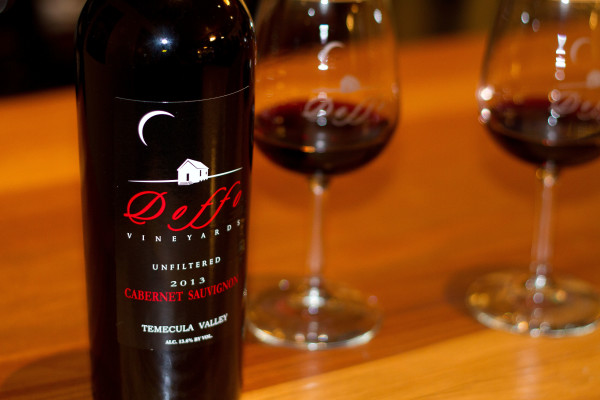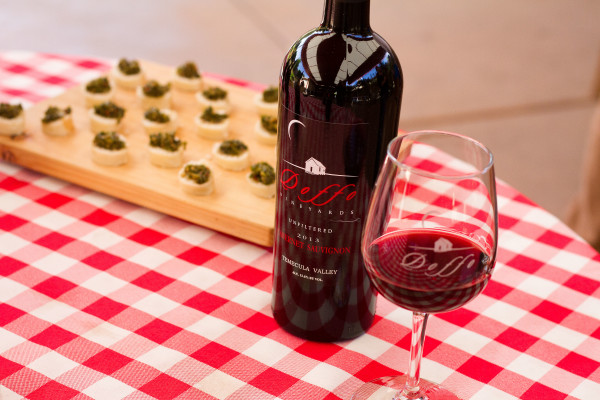Welcome to our Featured Wine series! Each month Damian will profile a Doffo wine, giving you a little bit of back story about the winemaking process, what to expect when you taste it, and what kinds of foods to pair it with. We hope you enjoy and visit us soon to learn more about our handcrafted wines! Our Featured Wine of the Month for March is our 2013 Cabernet Sauvignon.

Here at Doffo Winery we’ve developed a reputation for our bold, full-flavored reds, and our 2013 Cabernet Sauvignon is no exception. It is certainly one of the best known varietals, and is grown in almost every single wine region in the world. This varietal is actually not very old, as far as grape-growing and wine-producing goes. It was originated in the 1600s in France, the result of a cross between Cabernet Franc and Sauvignon Blanc vines.
We source our grapes for this particular wine from a single vineyard roughly 2.5 miles from Doffo Winery. We have a co-op agreement with the owners of the vineyard; Doffo does all of the farming and harvesting at no cost to the landowner. At the time of harvest, the cost of farming the vineyard is applied towards the purchase of the crop, so it’s a win-win situation. We receive fruit from a vineyard that we farm to our very meticulous standards, and the vineyard owner gets a fair market price for his crop with no out-of-pocket expenses except irrigation.
The Don Pasqual vineyard was planted in the late 90’s and is clone 337. This clone of Cabernet Sauvignon originated in the Bordeaux region of France. Clone 337 is highly desired by winemakers due to its natural varietal characteristic of suppressing the herbaceous or “green” character that is so common in Cabernet Sauvignon. Wines made from clone 337 tend to boast much more fruit-forward notes with heavy tones of red fruit and spice.
Our 2013 Cab is made of 100% Cabernet Sauvignon, entirely from this 337 lot. We chose to make this a single lot Cab because of its uniqueness and lush, heavy mouthfeel. It was aged in a combination of new and seasoned American oak barrels for 16 months, and is unfiltered.
The result is a full-bodied, intense violet red wine. The ’13 Cab is structured, rich and floral, bursting with berries, pepper and vanilla. As I mentioned above, it’s not as herbaceous as some Cabs but instead is much more fruit forward with heavy tones of spice and green bell pepper.

For appetizers, stick to the milder cheeses like cheddar or Brie, as stronger flavored cheese will compete too much with the wine. For dinner, meat dishes are a classic companion for Cabs, as the fats and proteins reduce some of the tannic qualities on the palate. I recommend trying pork loin stuffed with spinach and herbs, grilled baby back ribs, or roasted chicken with spicy Italian sausage. And contrary to popular belief, not all red wines go well with chocolate. If you have to satiate the craving, though, stick to a more bitter dark chocolate rather than a sweet milk chocolate.
The Cab Sauv’s acidity makes it a great candidate for aging, so enjoy our ’13 Cab now through 2020. Just remember to store it on its side (so the cork remains moist) and ideally in a climate controlled setting, like a cellar or wine refrigerator. Head on over to the Doffo shop to order your ’13 Cabernet Sauvignon.








The cab sounds intriguing, but for what it’s worth, I consider green pepper to be vegetal (pyrozine). I don’t like this quality in cab franc or in cab sauvignon. How do you distinguish beytween vegetal and green pepper?
Dan Duke, wine club member